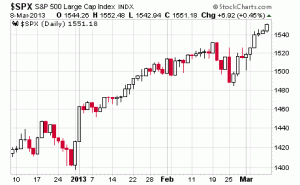Last week, with sequestration pending, President Obama and others warned of airplanes falling from the sky, tainted meat being served and schools being closed because of teacher layoffs. The budget cut news was so bleak, tours of the White House were canceled.
This week, the stock market hit a record high.
It may be a coincidence. The Washington Post gave sequestration no credit for the record and said the market was boosted by China’s announcement that it would put more money into the economy. There is, it seems, a Keynesian explanation for everything.
But, as The Wall Street Journal noted, “One thing for sure, the stock market doesn’t mind the federal budget sequester.”
The only mention of sequestration in the Post story was to note that “some” are warning that it could dampen economic growth. Of course, economic growth has been so slow, if it’s “dampened,” it’s possible that no one will notice.
Time to Invest in Stocks?
So with the record having been achieved, is it time to pile into the stock market?
Before you call your investment manager and shift your asset allocation to 100% stocks, consider the yin-yang of the current economy. In Chinese philosophy, yin-yang describes how seemingly opposite forces are interconnected and interdependent, which seems to fit the U.S. economy quite well.
On the yang side, as the Journal noted, “stocks are riding expanding U.S. factory activity, higher spending by U.S. businesses and consumers and a recovering housing market. Strong service-sector data released Tuesday added to the picture of an improving economy.”
Overall, the Dow stocks have a price-to-earnings ratio of 14, which is 20% below where it was in 2007. And even with this past week’s Dow record, there may be room for growth; if inflation is taken into consideration, the Dow would have to grow another 8% to break the record.
On the yin side, there are plenty of technical measures showing that the bull market is coming to an end. Current bullish sentiment is consistent with previous market peaks and the rising S&P 500 has formed a “rising wedge,” with advances taking place in an increasingly narrow band. And while P/E ratios as a whole remain reasonable, they have exceeded 100 for some major stocks.
The jobs report for February seems to reflect both yin and yang. Initially, the report was expected to show the unemployment rate remaining stuck at 7.9% and a gain of only 160,000 jobs, which would be down from the 177,000 average of the past six months.
Instead, the Labor Department report showed 236,000 new jobs and a drop in the unemployment rate to 7.7%. Then again, the Labor Department just revised the job total for January down from 157,000 to 119,000. Will the February totals be revised down next month?
Another point to ponder is the growing U.S. trade deficit. In spite of the weak dollar, the just-reported trade deficit increased significantly, from $38.1 billion in December to $44.4 billion in January. Imports of crude oil were a driving factor.
Consumer spending drives economic growth. If the jobless rate remains high and a weak dollar makes imports more expensive, growth will remain weak. At least we won’t have to worry about planes falling from the sky.

